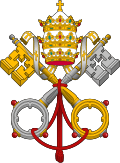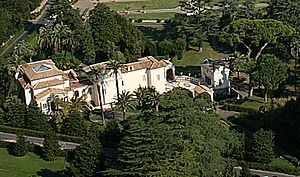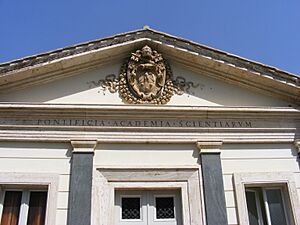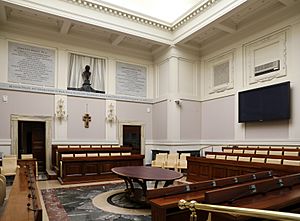Pontifical Academy of Sciences facts for kids
|
Pontificia accademia delle scienze
|
|
 |
|
| Type | Catholic, Research institute, Pontifical University |
|---|---|
| Established | 1936 |
| Chancellor | Peter Turkson |
| President | Joachim von Braun |
| Location |
Casina Pio IV
00120 Vatican City 41°54′15″N 12°27′9″E / 41.90417°N 12.45250°E |
The Pontifical Academy of Sciences is a special science group located in Vatican City. It was started in 1936 by Pope Pius XI. Its main goal is to help the mathematical, physical, and natural sciences grow. It also studies how we gain knowledge, which is called epistemology.
This academy has a long history. It comes from an older group called the "Academy of Lynxes," which began in Rome in 1603. That first academy was founded by Federico Cesi, a young botanist. Famous scientist Galileo Galilei was even a president of the original Academy of Lynxes. Today, the Pontifical Academy of Sciences is one of several important academies in the Vatican. Its main office is in the Casina Pio IV, a beautiful building in the Vatican Gardens.
Contents
History of the Academy
The first "Academy of Lynxes" was created by Federico Cesi. He wanted scientists to study nature very closely, like a lynx with its sharp eyes. Members of his academy were encouraged to learn through careful observation and experiments. The famous scientist Galileo Galilei was a leader of this early academy.
After its founder died, the first Academy of Lynxes stopped for a while. But it was brought back to life in 1847 by Pope Pius IX. It was then called the "Pontifical Academy of the New Lynxes." Later, in 1936, Pope Pius XI started it again with its current name, the Pontifical Academy of Sciences. Over the years, Pope Paul VI in 1976 and Pope John Paul II in 1986 updated its rules to keep it modern.
Since 1936, the Pontifical Academy of Sciences has focused on studying different science topics. It also works to bring different science fields together. The number of scientists in the academy has grown, and they come from all over the world. The academy is an independent group within the Vatican. This means it can do its research freely. Its goal is to help science grow and to study questions about how we understand scientific knowledge.
What the Academy Does
The academy and its members are not influenced by country, politics, or religion. This makes it a great source of fair and factual scientific information. This information is shared with the Vatican and with scientists around the world.
Today, the academy works in six main areas:
- Basic science
- Science and technology for big global issues
- Science to help problems in developing countries
- The ethics (right and wrong) and politics of science
- Bioethics (ethics in biology and medicine)
- Epistemology (how we know things)
The different science subjects covered include:
- Physics and related fields
- Astronomy
- Chemistry
- Earth and environmental sciences
- Life sciences (like botany, genetics, and brain studies)
- Mathematics
- Applied sciences (using science for practical things)
- The philosophy and history of sciences
The academy also publishes many important works, such as:
- Acta: These are records of their main meetings.
- Scripta Varia: These are major reports from their study groups.
- Documenta & Extra Series: These are quick summaries of their work and important speeches from the Pope.
- Commentarii: These are notes, memories, and special studies on science topics.
To encourage young scientists, the academy gives out the Pius XI Medal every two years. This award goes to a scientist under 45 who shows great promise. Some winners have even become members of the academy later on.
Goals and Hopes
The goals of the academy were clearly stated by Pope Pius XI when he restarted it in 1936. He said that true science and Christian faith are never in conflict. He believed that the Catholic Church has always supported scientific research. He also felt that science helps us understand the truths of faith better. Pope Pius XI hoped that the academy's scientists would work hard to advance science.
Later, on November 10, 1979, Pope John Paul II spoke about the academy's role again. He did this on the 100th birthday of Albert Einstein. He said that the academy, with its members from all backgrounds, shows how science and faith can work together. He explained that the Church cares deeply about the search for truth, which is a very human activity.
Pope John Paul II also mentioned that both religious and non-religious scientists are trying to understand nature's mysteries. He suggested that a believer might have an advantage because they know that nature's "puzzle" has a solution. This belief can help them stay hopeful and keep working hard, even when things are difficult.
On November 8, 2012, Pope Benedict XVI also spoke to the academy members. He stressed how important it is for faith and science to talk and work together. He said this cooperation is needed to build a culture that respects people and the planet. He believed that without faith and science informing each other, big questions about humanity might be left to unreason or indifference, which would harm everyone.
Members of the Academy
New members of the academy are chosen by the current academicians. They pick men and women from all races and religions. The main requirements are that they are excellent scientists and have high moral standards. Once chosen, the Pope officially appoints them.
The academy is led by a President, who is chosen by the Pope from the members. The President gets help from a scientific council and a Chancellor. When it first started, the academy had 80 members, with 70 appointed for life. In 1986, Pope John Paul II increased the number of lifetime members to 80. There are also a few Honorary Academicians and some members who are part of the academy because of their important jobs, like the Director of the Vatican Observatory.
Academy Presidents
The President of the academy is chosen by the Pope from its members. The current president is Joachim von Braun, who took on the role on June 21, 2017. Before him, Werner Arber, a Nobel Prize winner, was the first Protestant to be president.
Here is a list of past and current presidents of the Pontifical Academy of Sciences:
| Name | Start of Presidential Term | End of Presidential Term |
|---|---|---|
| Agostino Gemelli O.F.M. | 28 October 1936 | 15 July 1959 |
| Georges Lemaître | 19 March 1960 | 20 June 1966 |
| Daniel Joseph Kelly O'Connell | 15 January 1968 | 15 January 1972 |
| Carlos Chagas Filho | 9 November 1972 | 30 October 1988 |
| Giovanni Battista Marini Bettolo Marconi | 31 October 1988 | 29 March 1993 |
| Nicola Cabibbo | 30 March 1993 | 16 August 2010 |
| Werner Arber | 20 December 2010 | 20 June 2017 |
| Joachim von Braun | 21 June 2017 | - |
See also
 In Spanish: Pontificia Academia de las Ciencias para niños
In Spanish: Pontificia Academia de las Ciencias para niños
- Catholic Church & science
- Science and the Popes





